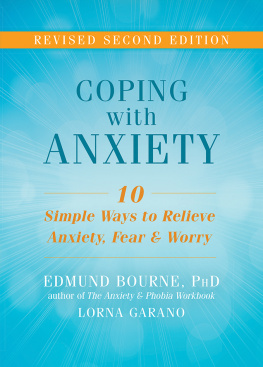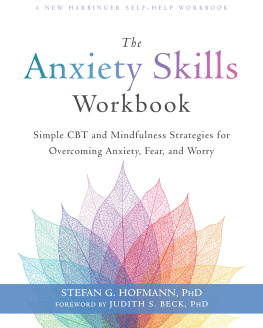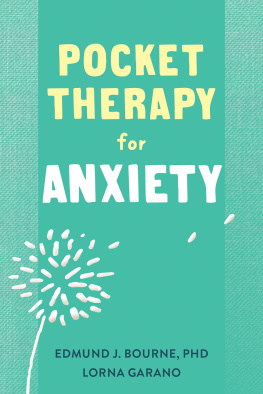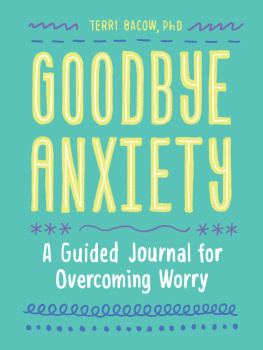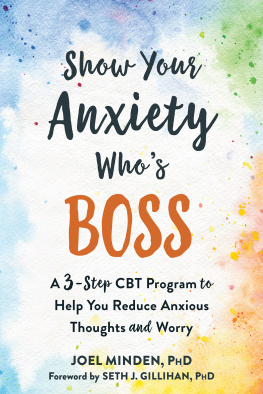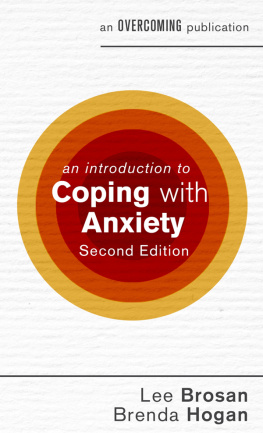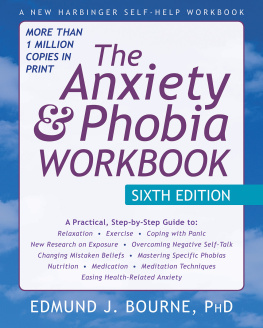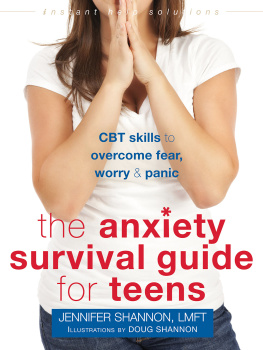
Bourne and Garano offer a delightfully helpful workbook for those who experience anxiety and those who counsel them. It is up-to-date, thorough, and most importantly, doable! Readers will find it immensely practical and impactful.
Timothy A. Sisemore, PhD, director of research and professor of counseling and psychology at Richmont Graduate University, and author of The Clinicians Guide to Exposure Therapies for Anxiety Spectrum Disorders
Edmund Bourne, in the revised second edition of Coping with Anxiety, a step-by-step self-help book, expertly guides readers through ten ways to reduce anxiety and improve coping skills. He covers relaxation, thinking skills, confronting challenging situations, exercise, and diet, as well as ways to nourish oneself, simplify life, and reduce worry. He includes exercises and questionnaires. The book is an important and highly useful contribution to the field.
Lynne Henderson, founder of the Social Fitness Center; founder and codirector, with Philip Zimbardo, of The Shyness Institute; and author of Helping Your Shy and Socially Anxious Client and The Compassionate-Mind Guide to Building Social Confidence
Edmund Bourne is one of the top experts on the subject of anxiety. Coping with Anxiety is a valuable, up-to-date resource filled with very helpful information for those who suffer from anxiety, and for professionals who want to expand their knowledge in this area. This book provides a road map to creating a calmer, more relaxed, and peaceful way of life.
Janet E. Esposito, MSW, author of In the SpotLight and Getting Over Stage Fright
In their new book, Coping with Anxiety, Edmund Bourne and Lorna Garano have done a very nice job of updating and adding new approaches to the first edition of the book. The authors note in the introduction that in a single year, some fifty million Americans suffer with anxiety of some form. In Coping with Anxiety, they offer readers many helpful, accessible, and quite varied methods to better manage and cope with whatever form of anxiety they face. This book is a broad and accessible resource for anyone struggling to manage anxiety.
Jeffrey Brantley, MD, founding director of the Mindfulness Based Stress Reduction Program at Duke Integrative Medicine, assistant consulting professor in the department of psychiatry and behavioral science at Duke University Medical Center, author of Calming Your Anxious Mind, and coauthor of Daily Meditations for Calming Your Angry Mind
This engaging book has an easy, encouraging, and calming flow. Practically everyone who suffers from one or more form of anxiety can greatly benefit from following the authors carefully mapped, scientifically supported path to relief from anxiety.
Bill Knaus, EdD, author of The Cognitive Behavioral Workbook for Depression and The Cognitive Behavioral Workbook for Anxiety
Here is a book for all of us. Coping with Anxiety teaches us to quiet our noisy worries, settle our problems rationally, smooth out our daily tensions, and nourish our physical body. Living life to the fullest means that we must weather all kinds of challenges. Within these pages we learn how to find the calm in the eye of the storm.
Reid Wilson, PhD, author of Stopping the Noise in Your Head
This is the first book anyone struggling with anxiety should read. It offers clear and effective help, and proven and doable solutions. An extraordinary resource for overcoming fear and anxiety.
Matthew McKay, PhD, coauthor of Thoughts and Feelings
Just when you thought a manual was perfect, Ed Bourne has improved on it. One of the most comprehensive, relatable, and easy-to-implement manuals on how to relieve your anxiety. Highly recommended.
Jennifer V. Owens MA, LPC, counselor specializing in treating anxiety disorders incorporating cognitive behavioral therapy (CBT), and founder of Fly with the Greatest of Ease, a program for fearful fliers
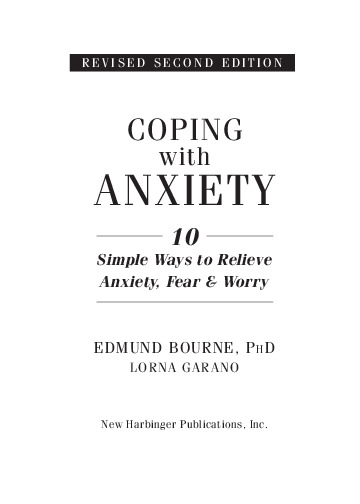
Publishers Note
This publication is designed to provide accurate and authoritative information in regard to the subject matter covered. It is sold with the understanding that the publisher is not engaged in rendering psychological, financial, legal, or other professional services. If expert assistance or counseling is needed, the services of a competent professional should be sought.
Distributed in Canada by Raincoast Books
Copyright 2016 by Edmund J. Bourne and Lorna Garano
New Harbinger Publications, Inc.
5674 Shattuck Avenue
Oakland, CA 94609
www.newharbinger.com
Cover design by Amy Shoup; Text design by Michele Waters;
Acquired by Catharine Meyers; Edited by Jean Blomquist
All Rights Reserved
Library of Congress Cataloging-in-Publication Data on file
Contents
For all who seek a more peaceful way to live.
Ed Bourne
For my parents.
Lorna Garano
Anxiety is increasingly prevalent in modern society. Approximately 18 percent of the population of the United States, or nearly 50 million people, have suffered from an anxiety disorder in the past year. Collectively, anxiety disorders are the most common behavioral disorder experienced by Americans. Why is anxiety so common in our time? Is there something about contemporary society that especially promotes anxiety? Throughout history, people have been exposed to challenging events in the form of wars, famines, plagues, and disease. Yet anxiety seems to be particularly characteristic of our modern era. Whats wrong?
In trying to account for the current prevalence of anxiety, at least three factors might be cited: the pace of modern life, a general lack of consensus about standards and values to live by, and the level of social alienation fostered by postindustrial society.
The pace of modern life has increased dramatically in recent decades. Films of people from fifty years ago show conclusively that people walked, drove, and lived more slowly than they do at present. Most of us live our lives in a state of constant doing, at odds with the natural rhythms of our bodies. Deprived of rest and time to just let ourselves be, we become detached from ourselves and more anxious.
Along with the rapid pace of daily life, we all face an unprecedented pace of social, technological, and environmental change. Our environment and social order have changed more in the past fifty years than they did in the preceding three hundred years. The rate of change is only likely to increase in the future. Without adequate time to assimilate and adjust to all of this change, we find ourselves growing more anxious.
Norms in modern life are highly pluralistic. There is no shared, consistent, socially-agreed-upon set of values and standards for people to live by, as there tended to be prior to 1960. In the vacuum left, most of us attempt to fend for ourselves, and the resultant uncertainty about how to conduct our lives leaves ample room for anxiety. Faced with a barrage of inconsistent worldviews and standards presented by the media, we are left with the responsibility of having to create our own meaning and moral order. When we are unable to find that meaning, many of us are prone to fill the gap thats left with various forms of escapism and addiction. We tend live out of tune with ourselves and thus find ourselves anxious.
Next page
